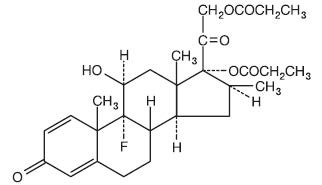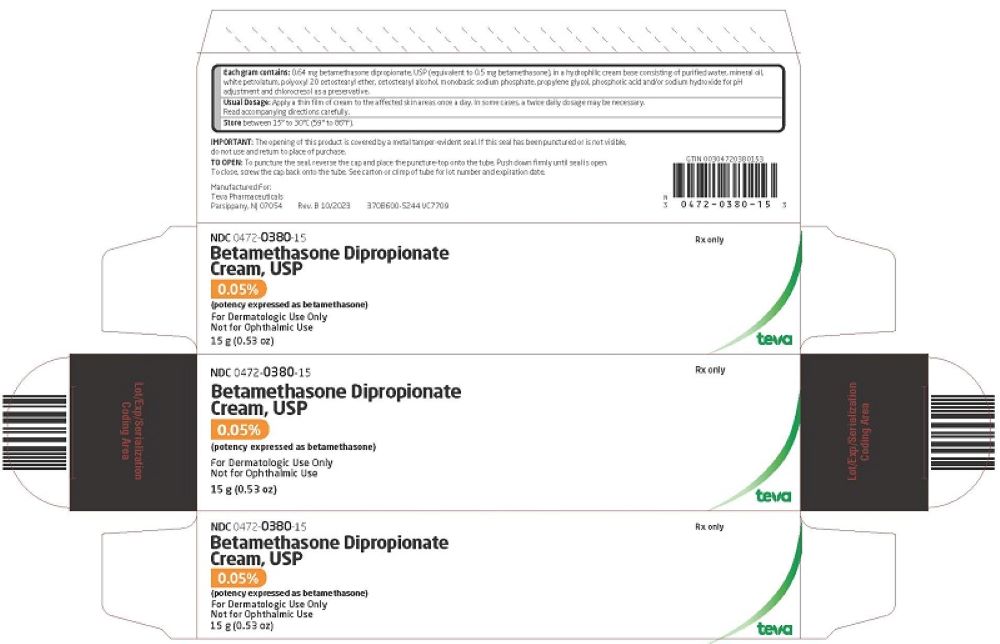Label: BETAMETHASONE DIPROPIONATE cream
- NDC Code(s): 0472-0380-15, 0472-0380-45
- Packager: Actavis Pharma, Inc.
- Category: HUMAN PRESCRIPTION DRUG LABEL
- DEA Schedule: None
- Marketing Status: Abbreviated New Drug Application
Drug Label Information
Updated October 1, 2023
If you are a consumer or patient please visit this version.
- Download DRUG LABEL INFO: PDF XML
- Official Label (Printer Friendly)
-
DESCRIPTION
Betamethasone dipropionate cream contains betamethasone dipropionate, USP, a synthetic adrenocorticosteroid, for dermatologic use. Betamethasone, an analog of prednisolone, has high corticosteroid activity and slight mineral-ocorticoid activity. Betamethasone dipropionate is the 17,21-dipropionate ester of betamethasone.
Chemically, betamethasone dipropionate is 9-Fluoro-11 β, 17,21-trihydroxy-16β-methylpregna-1,4-diene-3,20-dione 17,21-dipropionate, with the empirical formula C28H37FO7, a molecular weight of 504.6, and the following structural formula:

Betamethasone dipropionate is a white to creamy white, odorless crystalline powder, insoluble in water.
Each gram of betamethasone dipropionate cream 0.05% contains: 0.64 mg betamethasone dipropionate USP (equivalent to 0.5 mg betamethasone) in a hydrophilic cream base consisting of purified water, mineral oil, white petrolatum, polyoxyl 20 cetostearyl ether, cetostearyl alcohol, monobasic sodium phosphate, propylene glycol, phosphoric acid and/or sodium hydroxide for pH adjustment and chlorocresol as a preservative.
-
CLINICAL PHARMACOLOGY
The corticosteroids are a class of compounds comprising steroid hormones, secreted by the adrenal cortex and their synthetic analogs. In pharmacologic doses corticosteroids are used primarily for their anti-inflammatory and/or immunosuppressive effects.
Topical corticosteroids, such as betamethasone dipropionate, are effective in the treatment of corticosteroid-responsive dermatoses primarily because of their anti-inflammatory, antipruritic, and vasoconstrictive actions. However, while the physiologic, pharmacologic, and clinical effects of the corticosteroids are well known, the exact mechanisms of their actions in each disease are uncertain. Betamethasone dipropionate, a corticosteroid, has been shown to have topical (dermatologic) and systemic pharmacologic and metabolic effects characteristic of this class of drugs.
Pharmacokinetics: The extent of percutaneous absorption of topical corticosteroids is determined by many factors including the vehicle, the integrity of the epidermal barrier, and the use of occlusive dressings (see DOSAGE AND ADMINISTRATION).
Topical corticosteroids can be absorbed from normal intact skin. Inflammation and/or other disease processes in the skin increase percutaneous absorption. Occlusive dressings substantially increase the percutaneous absorption of topical corticosteroids (see DOSAGE AND ADMINISTRATION).
Once absorbed through the skin, topical corticosteroids are handled through pharmacokinetic pathways similar to systemically administered corticosteroids. Corticosteroids are bound to plasma proteins in varying degrees. Corticosteroids are metabolized primarily in the liver and are then excreted by the kidneys. Some of the topical corticosteroids and their metabolites are also excreted into the bile.
Sixty-three pediatric patients ages 1 to 12 years, with atopic dermatitis, were enrolled in an open-label, hypothalamic-pituitary-adrenal (HPA) axis safety study. Betamethasone dipropionate cream was applied twice daily for 2 to 3 weeks over a mean body surface area of 40% (range 35% to 90%). In 10 of 43 (23%) evaluable patients, adrenal suppression was indicated by either a less than or equal to 5 mcg/dL pre-stimulation cortisol, or a cosyntropin post-stimulation cortisol less than or equal to 18 mcg/dL and/or an increase of less than 7 mcg/dL from the baseline cortisol.
Studies performed with betamethasone dipropionate cream indicate that it is in the medium range of potency as compared with other topical corticosteroids.
- INDICATIONS AND USAGE
- CONTRAINDICATIONS
-
PRECAUTIONS
General: Systemic absorption of topical corticosteroids has produced reversible hypothalamic-pituitary-adrenal (HPA) axis suppression, manifestations of Cushing’s syndrome, hyperglycemia, and glucosuria in some patients.
Conditions which augment systemic absorption include the application of the more potent steroids, use over large surface areas, prolonged use, and the addition of occlusive dressings. Use of more than one corticosteroid-containing product at the same time may increase total systemic glucocorticoid exposure (see DOSAGE AND ADMINISTRATION).
Therefore, patients receiving a large dose of a potent topical steroid applied to a large surface area should be evaluated periodically for evidence of HPA axis suppression by using the urinary-free cortisol and ACTH stimulation tests. If HPA axis suppression is noted, an attempt should be made to withdraw the drug, to reduce the frequency of application, or to substitute a less potent steroid.
Recovery of HPA axis function is generally prompt and complete upon discontinuation of the drug. In an open-label pediatric study of 43 evaluable patients, of the 10 subjects who showed evidence of suppression, 2 subjects were tested 2 weeks after discontinuation of betamethasone dipropionate cream, 0.05%, and 1 of the 2 (50%) had complete recovery of HPA axis function. Infrequently, signs and symptoms of steroid withdrawal may occur, requiring supplemental systemic corticosteroids.
Pediatric patients may absorb proportionally larger amounts of topical corticosteroids and thus be more susceptible to systemic toxicity (see PRECAUTIONS – Pediatric Use).
If irritation develops, topical corticosteroids should be discontinued and appropriate therapy instituted. In the presence of dermatological infections, the use of an appropriate antifungal or antibacterial agent should be instituted. If a favorable response does not occur promptly, the corticosteroid should be discontinued until the infection has been adequately controlled.
Information For Patients: This information is intended to aid in the safe and effective use of this medication. It is not a disclosure of all possible adverse or intended effects. Patients using topical corticosteroids should receive the following information and instructions:
- This medication is to be used as directed by the physician. It is for external use only. Avoid contact with the eyes.
- Patients should be advised not to use this medication for any disorder other than that for which it was prescribed.
- The treated skin area should not be bandaged or otherwise covered or wrapped as to be occlusive (see DOSAGE AND ADMINISTRATION).
- Patients should report any signs of local adverse reactions.
- Other corticosteroid-containing products should not be used with betamethasone dipropionate cream without first talking to your physician.
Laboratory Tests: The following tests may be helpful in evaluating HPA axis suppression:
Urinary-free cortisol test
ACTH stimulation testCarcinogenesis, Mutagenesis, and Impairment of Fertility: Long-term animal studies have not been performed to evaluate the carcinogenic potential of betamethasone dipropionate.
Betamethasone was negative in the bacterial mutagenicity assay (Salmonella typhimurium and Escherichia coli), and in the mammalian cell mutagenicity assay (CHO/HGPRT). It was positive in the in-vitro human lymphocyte chromosome aberration assay, and equivocal in the in-vivo mouse bone marrow micronucleus assay. This pattern of response is similar to that of dexamethasone and hydrocortisone.
Reproductive studies with betamethasone dipropionate carried out in rabbits at doses of 1.0 mg/kg by the intramuscular route and in mice up to 33 mg/kg by the intramuscular route indicated no impairment of fertility except for dose related increases in fetal resorption rates in both species.
These doses are approximately 0.5 and 4 fold the estimated maximum human dose based on a mg/m2 comparison, respectively.
Pregnancy: Teratogenic Effects:
Corticosteroids are generally teratogenic in laboratory animals when administered systemically at relatively low dosage levels.Betamethasone dipropionate has been shown to be teratogenic in rabbits when given by the intramuscular route at doses of 0.05 mg/kg. This dose is approximately 0.03 fold the estimated maximum human dose based on a mg/m2 comparison. The abnormalities observed included umbilical hernias, cephalocele and cleft palates.
Some corticosteroids have been shown to be teratogenic after dermal application in laboratory animals. There are no adequate and well-controlled studies in pregnant women on teratogenic effects from topically applied corticosteroids. Therefore, topical corticosteroids should be used during pregnancy only if the potential benefit justifies the potential risk to the fetus. Drugs of this class should not be used extensively on pregnant patients, in large amounts, or for prolonged periods of time.
Nursing Mothers: It is not known whether topical administration of corticosteroids could result in sufficient systemic absorption to produce detectable quantities in breast milk. Systemically administered corticosteroids are secreted into breast milk in quantities not likely to have a deleterious effect on the infant. Nevertheless, caution should be exercised when topical corticosteroids are prescribed for a nursing woman.
Pediatric Use: Use of betamethasone dipropionate cream, 0.05%, in pediatric patients 12 years of age and younger is not recommended (see CLINICAL PHARMACOLOGY and ADVERSE REACTIONS sections).
In an open-label study, 10 of 43 (23%) evaluable pediatric patients (aged 2 years to 12 years old) using betamethasone dipropionate cream for treatment of atopic dermatitis for 2 to 3 weeks demonstrated HPA axis suppression. The proportion of patients with adrenal suppression in this study was progressively greater, the younger the age group (see CLINICAL PHARMACOLOGY – Pharmacokinetics).
Pediatric patients may demonstrate greater susceptibility to topical corticosteroid-induced HPA axis suppression and Cushing’s syndrome than mature patients because of a larger skin surface area to body weight ratio. The study described above supports this premise, as suppression in 9 to 12 year olds, 6 to 8 year olds, and 2 to 5 year olds was 14%, 23%, and 30%, respectively.
Hypothalamic-pituitary-adrenal (HPA) axis suppression, Cushing’s syndrome, and intracranial hypertension have been reported in pediatric patients receiving topical corticosteroids. Manifestations of adrenal suppression in pediatric patients include linear growth retardation, delayed weight gain, low plasma cortisol levels, and absence of response to ACTH stimulation. Manifestations of intracranial hypertension include bulging fontanelles, headaches, and bilateral papilledema.
Administration of topical corticosteroids to pediatric patients should be limited to the least amount compatible with an effective therapeutic regimen. Chronic corticosteroid therapy may interfere with the growth and development of pediatric patients.
-
ADVERSE REACTIONS
The following local adverse reactions are reported infrequently when betamethasone dipropionate cream is used as recommended in the DOSAGE AND ADMINISTRATION section. These reactions are listed in an approximate decreasing order of occurrence: burning, itching, irritation, dryness, folliculitis, hypertrichosis, acneiform eruptions, hypopigmentation, perioral dermatitis, allergic contact dermatitis, maceration of the skin, secondary infection, skin atrophy, striae, miliaria.
Adverse reactions reported to be possibly or probably related to treatment with betamethasone dipropionate cream during a pediatric clinical study include signs of skin atrophy (bruising, shininess). Skin atrophy occurred in 3 of 63 (5%) patients, a 3-year old, a 5-year old, and a 7-year old.
Systemic absorption of topical corticosteroids has produced reversible hypothalamic-pituitary-adrenal (HPA) axis suppression, manifestations of Cushing’s syndrome, hyperglycemia, and glucosuria in some patients.
To report SUSPECTED ADVERSE REACTIONS, contact Teva Pharmaceuticals USA, Inc. at 1-888-838-2872 or FDA at 1-800-FDA-1088 or http://www.fda.gov/medwatch.
-
OVERDOSAGE
Topically applied corticosteroids can be absorbed in sufficient amounts to produce systemic effects (see PRECAUTIONS).
- DOSAGE AND ADMINISTRATION
- HOW SUPPLIED
- PACKAGE LABEL.PRINCIPAL DISPLAY PANEL
-
INGREDIENTS AND APPEARANCE
BETAMETHASONE DIPROPIONATE
betamethasone dipropionate creamProduct Information Product Type HUMAN PRESCRIPTION DRUG Item Code (Source) NDC:0472-0380 Route of Administration TOPICAL Active Ingredient/Active Moiety Ingredient Name Basis of Strength Strength BETAMETHASONE DIPROPIONATE (UNII: 826Y60901U) (BETAMETHASONE - UNII:9842X06Q6M) BETAMETHASONE 0.5 mg in 1 g Inactive Ingredients Ingredient Name Strength WATER (UNII: 059QF0KO0R) MINERAL OIL (UNII: T5L8T28FGP) PETROLATUM (UNII: 4T6H12BN9U) POLYOXYL 20 CETOSTEARYL ETHER (UNII: YRC528SWUY) CETOSTEARYL ALCOHOL (UNII: 2DMT128M1S) SODIUM PHOSPHATE, MONOBASIC (UNII: 3980JIH2SW) PROPYLENE GLYCOL (UNII: 6DC9Q167V3) PHOSPHORIC ACID (UNII: E4GA8884NN) SODIUM HYDROXIDE (UNII: 55X04QC32I) CHLOROCRESOL (UNII: 36W53O7109) Packaging # Item Code Package Description Marketing Start Date Marketing End Date 1 NDC:0472-0380-15 1 in 1 CARTON 09/03/2002 1 15 g in 1 TUBE; Type 0: Not a Combination Product 2 NDC:0472-0380-45 1 in 1 CARTON 09/03/2002 2 45 g in 1 TUBE; Type 0: Not a Combination Product Marketing Information Marketing Category Application Number or Monograph Citation Marketing Start Date Marketing End Date ANDA ANDA070885 09/03/2002 Labeler - Actavis Pharma, Inc. (119723554)


